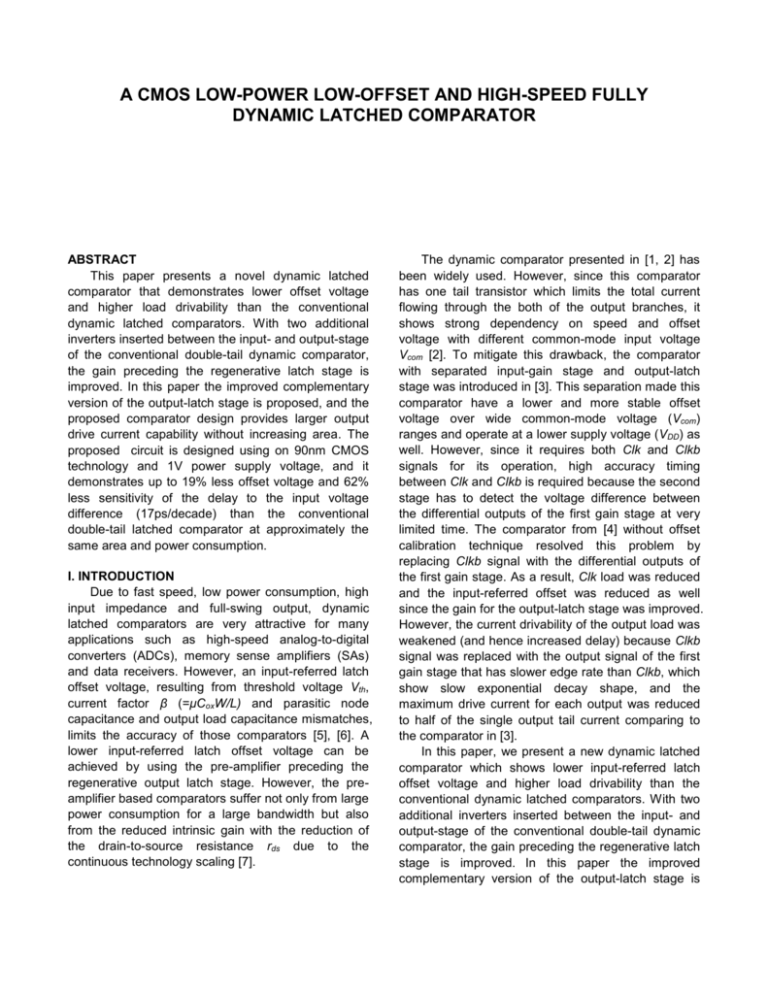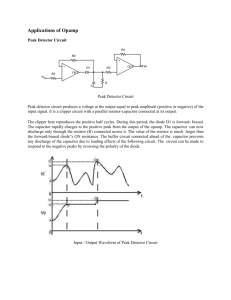asic 2001: formatting and submitting your paper
advertisement

A CMOS LOW-POWER LOW-OFFSET AND HIGH-SPEED FULLY
DYNAMIC LATCHED COMPARATOR
HeungJun Jeon and Yong-Bin Kim
Department of Electrical and Computer Engineering
Northeastern University
Boston, MA, USA
hjeon@ece.neu.edu and ybk@ece.neu.edu
ABSTRACT
This paper presents a novel dynamic latched
comparator that demonstrates lower offset voltage
and higher load drivability than the conventional
dynamic latched comparators. With two additional
inverters inserted between the input- and output-stage
of the conventional double-tail dynamic comparator,
the gain preceding the regenerative latch stage is
improved. In this paper the improved complementary
version of the output-latch stage is proposed, and the
proposed comparator design provides larger output
drive current capability without increasing area. The
proposed circuit is designed using on 90nm CMOS
technology and 1V power supply voltage, and it
demonstrates up to 19% less offset voltage and 62%
less sensitivity of the delay to the input voltage
difference (17ps/decade) than the conventional
double-tail latched comparator at approximately the
same area and power consumption.
I. INTRODUCTION
Due to fast speed, low power consumption, high
input impedance and full-swing output, dynamic
latched comparators are very attractive for many
applications such as high-speed analog-to-digital
converters (ADCs), memory sense amplifiers (SAs)
and data receivers. However, an input-referred latch
offset voltage, resulting from threshold voltage Vth,
current factor β (=μCoxW/L) and parasitic node
capacitance and output load capacitance mismatches,
limits the accuracy of those comparators [5], [6]. A
lower input-referred latch offset voltage can be
achieved by using the pre-amplifier preceding the
regenerative output latch stage. However, the preamplifier based comparators suffer not only from large
power consumption for a large bandwidth but also
from the reduced intrinsic gain with the reduction of
the drain-to-source resistance rds due to the
continuous technology scaling [7].
The dynamic comparator presented in [1, 2] has
been widely used. However, since this comparator
has one tail transistor which limits the total current
flowing through the both of the output branches, it
shows strong dependency on speed and offset
voltage with different common-mode input voltage
Vcom [2]. To mitigate this drawback, the comparator
with separated input-gain stage and output-latch
stage was introduced in [3]. This separation made this
comparator have a lower and more stable offset
voltage over wide common-mode voltage (Vcom)
ranges and operate at a lower supply voltage (VDD) as
well. However, since it requires both Clk and Clkb
signals for its operation, high accuracy timing
between Clk and Clkb is required because the second
stage has to detect the voltage difference between
the differential outputs of the first gain stage at very
limited time. The comparator from [4] without offset
calibration technique resolved this problem by
replacing Clkb signal with the differential outputs of
the first gain stage. As a result, Clk load was reduced
and the input-referred offset was reduced as well
since the gain for the output-latch stage was improved.
However, the current drivability of the output load was
weakened (and hence increased delay) because Clkb
signal was replaced with the output signal of the first
gain stage that has slower edge rate than Clkb, which
show slow exponential decay shape, and the
maximum drive current for each output was reduced
to half of the single output tail current comparing to
the comparator in [3].
In this paper, we present a new dynamic latched
comparator which shows lower input-referred latch
offset voltage and higher load drivability than the
conventional dynamic latched comparators. With two
additional inverters inserted between the input- and
output-stage of the conventional double-tail dynamic
comparator, the gain preceding the regenerative latch
stage is improved. In this paper the improved
complementary version of the output-latch stage is
Figure 1 (a) Schematic of the proposed comparator; (b) Signal behavior of proposed comparator (ΔVin=100mV (Grey), 10mV (Black) with
VDD=1V, fclk=3GHz, Cload=7fF, Temp.=25oC and Vcom=0.7V)
proposed, and the proposed comparator design
provides larger output drive current capability without
increasing area. The proposed circuit demonstrates
up to 19% less input-referred latch offset voltage and
62% less sensitivity of the delay versus the input
voltage difference (delay/log(ΔVin)), which is about
17ps/decade, than the conventional double-tail
latched comparator at approximately the same area
and power consumption.
The remaining sections of the paper are
organized as follows. Section II provides comparisons
between the previous works and the proposed
comparator, section III describes the optimization of
the proposed comparator and the conclusion is
followed in Section IV.
II. COMPARISONS WITH PREVIOUS WORKS
The schematic and simulated waveforms of the
proposed comparator are shown in Figure 1. The
circuit is designed and simulated with HSPICE using
90nm PTM technology [8], and the design and
simulation conditions are VDD=1V, fclk=3GHz, Cload=7fF,
Temp.=25oC, and common mode voltage Vcom=0.7V.
The basic structure of the proposed comparator stems
from the comparators from [3] and [4]. Therefore, the
proposed comparator provides better input offset
characteristic and faster operation in addition to the
advantages of those comparators such as less
kickback noise, reduced clock load and removal of the
timing requirement between Clk and Clkb over a wide
common-mode and supply voltage range,
For its operation, during the pre-charge (or reset)
phase (Clk=0V), both PMOS transistors M4 and M5
are turned on and they charge Di nodes capacitance
to VDD, which makes both NMOS transistor M16 and
M17 of the inverters on and Di’ nodes discharge to
ground. Sequentially, PMOS transistor M10, M11, M14
ground. and M16 are turned on and Out nodes and Sw
nodes are charged to VDD while both NMOS
transistors M12 and M13 are off.
During evaluation (decision-making) phase
(Clk=VDD), each Di node capacitance is discharged
from VDD to ground in a different rate in proportion to
the magnitude of each input voltage. As a result, an
input dependent differential voltage is formed
between Di+ and Di- nodes. Once either Di+ or Dinode voltage drops down below around VDD - |Vtp|, the
additional inverter pairs M18/M16 and M19/M17 invert
each Di node signal into the regenerated (amplified)
Di’ node signal. Then the regenerated and different
phased Di’ node voltages are amplified again and
relayed to the output-latch stage by M10- M13. As the
regenerated each Di’ node voltage is rising from 0V
to VDD with a different time interval (or a phase
difference which increases with the increasing input
voltage difference ΔVin), M12 and M13 turn on one
after another and the output latch starts to regenerate
the small voltage difference transmitted from Di’
nodes into a full-scale digital level: Out+ node will
output logic high (VDD) if the voltage difference at Di’
nodes ΔDi’(t) is negative (Di+’(t) < Di-’(t)) and Out+
will be low (0V) otherwise. Once either of the Out
node voltages drops below around VDD - |Vtp|, this
positive feedback becomes stronger because either
PMOS transistor M8 or M9 will turn on.
To compare the performances of the comparators
Table 1: Performance Comparison
Number of
Transistors
Σ Width [μm]
|Delay [ps] / log(ΔVin)|
Offset Volatge [mV]
Energy [fJ] / Decision
Comparator [3]
14
20.6 μm
~ 33 ps/decade
20.1 mV
65.43 fJ
Comparator [4]
15
20.5 μm
~ 45 ps/decade
15.8 mV
58.43 fJ
Proposed
Comparator
19
20.5 μm
~ 17 ps/decade
16.3 mV
59.20 fJ
the delay to the input voltage difference (17ps/decade)
than the conventional double-tail latched comparator
at approximately the same area and power
consumption. As the size of the load gets larger, the
proposed comparator shows better overall speed over
the comparator [3] since the proposed comparator
can drive more current to the load than the
comparator [3] and [4] at the same area of the outputstage.
In order to compare the offset voltage of each
comparator, random mismatch in threshold voltage Vth
and current factor β (=μCoxW/L) were modeled as
follows,
Figure 2 Simulated delay (ps) versus ΔVin=|Vin+–Vin-| [V] with
different load capacitances of 7fF and 10fF (VDD=1V).
from [3], [4] with the proposed one, each circuit was
designed using 90nm PTM technology with VDD=1V
and simulated with HSPICE. In order to compare their
relative speeds and total offset voltages, each circuit
was designed to have the same CDi/I1 (Di nodes
capacitance/drain current of M1) ratio at the same
area. In addition, transconductance of M2 and M3 of
each comparator was kept constant by sizing the
widths of M2 and M3 to have 2μm. After setting the
widths of the mismatch critical transistors to have
relatively large size (>1μm), the rest sizes of
transistors are optimized for high speed, low offset
and less power consumption.
Figure 2 shows the simulated delay (ps) of each
comparator versus the input voltage difference (V)
with the different load capacitance of 7fF and 10fF.
The absolute delay was measured between the 30%
of the rising Clk edge to 70% of the rising output edge
for the comparator from [3] and [4] and to 30% of the
falling output edge for the proposed comparator. Even
with the additional inverter delays formed from
transistor M16-19, the proposed comparator outputs
faster decision over the comparator from [3] when
ΔVin is less than around 25mV with 7fF capacitance
load and less than around 50mV with 10fF
capacitance load, which shows 62% less sensitivity of
𝜎𝑉𝑡ℎ =
𝜎𝛽
=
𝐴𝑉𝑡ℎ
√𝑊𝐿
𝐴𝛽
√𝑊𝐿
𝑤ℎ𝑒𝑟𝑒 𝑊, 𝐿 𝑎𝑟𝑒 𝑖𝑛 𝜇𝑚
(1)
𝑤ℎ𝑒𝑟𝑒 𝑊, 𝐿 𝑎𝑟𝑒 𝑖𝑛 𝜇𝑚
(2)
Avth and Aβ are process dependent parameters and
assumed to be 3mV∙μm and 1%∙μm, respectively in
our mismatch analysis.
The overall performance comparison of each
comparator is summarized in Table 1. The fifth
column in Table 1 shows the resulting input-referred
total offset voltage (VOS) from 500 iterations of Monte
Carlo transient simulations with 7fF capacitance load,
Vcom=0.7V and VDD=1V. The simulated result shows
that the resulting VOS of the proposed one is 16.3mV
which is 3.8mV less than that of the comparator [3]
and comparable with that of the comparator [4]. The
second and third columns show the number of
transistors and total channel widths of the transistors,
which can be considered as approximate measures of
circuit complexity and chip area. The fourth column is
the delays (ps) per the input voltage differences
(log(ΔVin) or decade) of each comparator. The sixth
and last column in Table 1 shows that the proposed
comparator consumes even less energy than the
comparator [3] while presenting more stable
delay/log(ΔVin) and even less input-referred latch
offset voltage at the same area.
III. OPTIMIZATION OF THE PROPOSED
COMPARATOR
To further reduce the offset voltage of the
proposed comparator, it is necessary to find the most
critical mismatch transistor pairs first. Since transistor
M2 and M3 pair is the input transistors and starts to
operate in saturation region during evaluation phase,
they are the most critical mismatch pair of the total
offset voltage and the offset voltage caused by the
mismatch between them can be expressed as
𝑉𝐺𝑆2,3 − 𝑉𝑡𝑛 2 ∆𝐶𝐷𝑖 2
∆𝛽 2
𝑉𝑂𝑆2,3 2 = (
) {(
) + ( ) } + ∆𝑉𝑡𝑛2,3 2
2
𝐶𝐷𝑖
𝛽
(3)
Equation (3) shows that VOS2,3 is affected by
device mismatches and bias conditions. It implies that
the total offset voltage increases in direct proportion
to the threshold voltage mismatch Vtn2,3 and also
increases with the increase of common mode voltage
Vcom, Di node capacitance mismatch (which is the
gate capacitance mismatch of the inverter pair), and
the current factor β mismatch. From (1) and (2), it is
clear that offset voltage can be reduced by increasing
transistor size.
In addition, to minimize the input-referred outputstage combined with latch, gain of the dynamic
preamplifier should be maximized. Assuming that
λ=γ=0 and t is between t1 and t2, while VDS2,3 ≥
VGS2,3−Vtn2,3 (VDi ≥ Vcom−Vth2,3) starting from the point
transistor M1 just turns on at the rising Clk edge, the
dynamic gain of the first stage can be defined as
𝐴𝑉1 (𝑡) = −
𝑔𝑚2,3
𝑡
𝐶𝐷𝑖
(4)
to 120nm in 90nm technology, one can get higher
gain with the same W 2,3/L ratio by reducing shortchannel effects such as a dynamic conductance
variation due to DIBL. If a negative supply voltage is
available, by replacing the ground of the input
differential pair with a negative supply voltage and
further reducing the size of transistor M1, one can get
wider common mode input range. Therefore, this
differential input stage can be designed in a different
way depending on the requirements such as the
speed, offset voltage and common mode input
voltage range.
From the simulation result, the dynamic voltage
gain up to around 12 V/V can be easily obtained,
where around 1.7 times of the gain is produced by the
inverter pairs (M18/M16 and M19/M17) followed by Di
node gain of around 7 V/V. It means that the input
referred offset voltage caused from the output-latch
stage is reduced by 12 times. Therefore, the output
stage is relatively offset insensitive and does not need
to be designed too big. Instead, the offset voltage
caused from mismatch between the inverter pairs is
the second dominant component of the total offset
voltage and both pairs need to be designed big
enough to meet the offset requirement.
IV. CONCLUSION
In this paper, we present a new dynamic latched
comparator which shows lower offset voltage and
higher output load drivability over the conventional
double-tail dynamic latched comparator. It shows up
to 19% less offset voltage and 62% less sensitivity of
the delay versus the input voltage difference
(delay/log(ΔVin)), which is about 17ps/decade, than
the conventional double-tail latched comparator at
approximately the same area and power consumption.
REFERENCES
Equation (4) shows that as long as transistor M2
and M3 operate in saturation region and ∆Vin does not
change over [t1, t2], the dynamic gain AV1(t) keeps
increasing with increasing t. Since t is proportional to
CDi/ID2,3, in order to maximize the gain, |gm2/ID2,3|
should be maximized during integration time. Except
for the sub-threshold operation, gm/ID is larger in
saturation operation than linear operation. Therefore,
as the size (W 1) of transistor M1 is reduced, the input
transistor remains in saturation region longer. This, in
turn, increases the gain of the first stage at the cost of
increasing delay. In addition, by increasing the
channel length of input transistor, for example 90nm
1. T. Kobayashi, K. Nogami, T. Shirotori and Y. Fujimoto, “A
current-controlled latch sense amplifier and a static powersaving input buffer for low-power architecture,” IEEE J. SolidState Circuits, vol. 28, pp. 523-52, April 1993.
2. B. Wicht, T. Nirschl, and D. Schmitt-Landsiedel, “Yield and
speed optimization of a latch-type voltage sense amplifier,”
IEEE J. Solid-State Circuits, vol. 39, pp. 1148-1158, July 2004.
3. D. Schinkel, E. Mensink, E. Kiumperink, E. van Tuijl and B.
Nauta, “A Double-Tail Latch-Type Voltage Sense Amplifier with
18ps Setup+Hold Time,” ISSCC Dig. Tech. Papers, pp. 314315 and 605, Feb. 2007.
4. M. Miyahara, Y. Asada, P. Daehwa and A. Matsuzawa, “A LowNoise Self-Calibrating Dynamic Comparator for High-Speed
ADCs,” in Proc. A-SSCC, pp. 269-272, Nov. 2008.
5. Jun He, Sanyi Zhan, Degang Chen, and R.L. Geiger, “Analyses
of Static and Dynamic Random Offset Voltages in Dynamic
Comparators,” IEEE Trans. Circuits Syst. I: Reg. Papers, vol.
56, pp. 911-919, May 2009.
6. Nikoozadeh and B. Murmann, “An Analysis of Latch
Comparator Offset Due to Load Capacitor Mismatch,” IEEE
Trans. Circuits Syst. II: Exp. Briefs, vol. 53, no. 12, pp. 13981402, Dec. 2006
7. B. Murmann et al., "Impact of scaling on analog performance
and associated modeling needs," IEEE Trans. Electron
Devices, vol. 53, no. 9, pp. 2160-2167, Sep. 2006.
8. http://www.eas.asu.edu/~ptm/latest.htm







